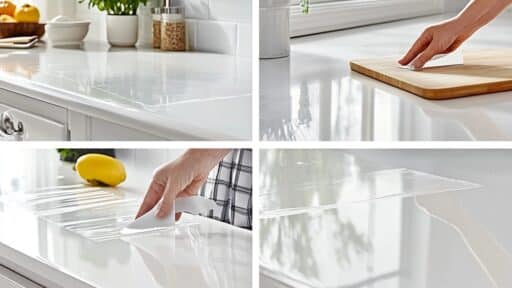Are you looking to update those dated popcorn ceilings but dreading the mess of scraping them off?
I found a better way—shiplap! After completing several ceiling makeovers, I’ve learned that covering popcorn ceilings with shiplap is not only easier but also cost-effective.
For about $1,000, you can transform 1,500 square feet of ceiling into a clean, modern look.
In this guide, I’ll share exactly how I did it, from choosing materials to maintaining your new ceiling.
Why choose shiplap over popcorn ceiling?
It’s much easier than scraping and re-texturing—you won’t have to deal with messy cleanup or spend days prepping the surface.
I’ve seen how shiplap turns old-looking ceilings into something clean and fresh.
The best part? You can do this project yourself, even if you’re new to DIY. You’ll need basic tools like a nail gun and some measuring skills.
The boards cover your existing ceiling, making your room look taller and more put-together.
Plus, the lines of the shiplap boards add a nice touch that makes the whole room feel more organized.
Your guide to installing shiplap over a popcorn ceiling!
Tools and Materials Needed
Tools:
- Mitre saw
- Jigsaw
- Nail gun and brad nails
- Stud finder
- Caulk gun
- Speed square and level
Materials:
- Pre-painted or primed shiplap boards.
- Construction adhesive.
- Caulk and quarter-round trim.
- Finishing kit (optional for a professional look).
Step 1: Prepare Your Space
- Clear the room and protect surfaces with drop cloths.
- Locate and mark ceiling studs/joists with a stud finder or tape.
Step 2: Measure and Cut the Shiplap Boards
- Measure the ceiling area for accurate board cuts.
- Use a miter saw for straight and clean cuts.
- Consider making a template for repetitive cuts.
Step 3: Dry Fit and Plan
- Dry fit the first board to ensure proper alignment.
- Use a speed square to check for level placement.
Step 4: Apply Adhesive
- Load construction adhesive into a caulk gun.
- Apply evenly to the back of the shiplap board.
Step 5: Nail the Shiplap to the Ceiling
- Secure each board with a nail gun, ensuring alignment with the studs.
- Use spacers (e.g., coins) to maintain even gaps between boards.
Step 6: Address Fixtures and Odd Shapes
- Cut openings for light fixtures or vents with a jigsaw.
- Use templates for irregular corners or edges.
Step 7: Add Trim and Finishing Touches
- Install quarter-round trim to cover gaps and seams.
- Fill nail holes with caulk or a finishing kit for a polished look.
Design Tips for Shiplap Ceilings!

From my experience, board size makes a big difference. I went with 8-inch boards for my ceilings instead of 6-inch ones – they fill the space better and look more substantial up there.
For the finish, I started with a good primer. I picked up a pro tip: use a stain-blocking primer first.
This prevents the wood from turning yellow over time. I used pure white paint for my final coat, and it made the room look bright and clean.
Looking at the Florida condo makeover in our examples, white shiplap really gave the space that breezy, light feel. It’s perfect if you want your room to feel open and airy.
I tried something different for spacing between boards – I used two nickels as spacers instead of one.
This created more noticeable lines between the boards, which added more character to the ceiling.
Time Required for DIY
- Cutting boards: 1 day
- Installation: 2-3 days for a standard room
- Painting: 1-2 days (includes primer and final coat)
Money-Saving Tips for DIY
- Cut the plywood into boards yourself instead of buying pre-made shiplap
- Use spare pieces for small accent walls
- Buy tools you’ll use again, like the nail gun
Common challenges and how to overcome them
| Challenge | Description | Solution |
|---|---|---|
| Uneven Ceilings | Ceilings that are not perfectly level can cause gaps between boards. | – Use spacers (e.g., coins or shims) to maintain even gaps. – Apply caulk to fill visible gaps. |
| Steel Joists | Steel joists prevent nails from going fully into the studs. | – Cross-nail at an angle to create an “X” pattern for better hold. – Rely on strong construction adhesive for extra support. |
| Cutting Around Fixtures | Cutting precise openings for lights, vents, or fans can be tricky. | – Use a jigsaw for curved cuts. – Create a cardboard template for irregular shapes to avoid wasting material. |
How to clean and maintain shiplap ceilings
- Clean your shiplap ceiling with a dry microfiber duster or vacuum with a soft brush attachment.
- Clean more thoroughly 2-3 times a year with a slightly damp cloth
- Prevent warping: Use liquid adhesive and nails when installing nail boards securely into ceiling studs. Leave proper spacing between boards (two-nickel width works well)
- Avoid problems: Don’t use wet cleaning methods, check for loose nails yearly, fix any gaps with caulk as needed, and touch up paint when needed
- Keep your ceiling lasting longer: Use a stain-blocking primer before painting, apply two coats of paint for better protection, and fix any water leaks from above right away
- Check these spots regularly: Seams between boards, areas near vents or light fixtures, and corners where walls meet the ceiling
Are there alternative methods to cover a popcorn ceiling?
- Drop ceiling panels: Install a metal grid system and lightweight panels. It’s simple but reduces room height.
- PVC ceiling tiles: These stick right onto your existing ceiling. They’re light, water-resistant, and easy to clean.
- Drywall: You can put new drywall right over the popcorn. It’s a smooth finish but needs professional skills.
- Beadboard panels: Like shiplap, these add texture but come in larger sheets for faster installation.
- Wood planks: Similar to shiplap but with different width options and textures.
Remember: whichever method you pick, make sure your ceiling can handle the extra weight.
Summing Up
After helping many homeowners update their ceilings, I’ve seen firsthand how shiplap can change a room.
It’s more than just a cover-up – it’s a smart investment that adds style without the headache of traditional popcorn removal.
The best part is you can tackle this project over a weekend with basic DIY skills.
Whether you choose whiteboards for a coastal feel or a custom color, your ceiling will be professionally done.
Frequently Asked Questions
Do I need to remove the popcorn texture first?
No—you can install a shiplap directly over a popcorn ceiling.
Is it necessary to use furring strips?
No – direct installation using liquid adhesive and nails into ceiling studs for secure attachment is possible.
How much will this project cost?
About $1,000 covers 1,500 square feet, including plywood cut into boards, primer, paint, and basic tools.
Are there any safety issues, like asbestos, to consider?
Since you’re not scraping the ceiling, asbestos isn’t a concern. Just ensure you locate ceiling studs for proper installation.
Will installing a shiplap add height or improve the look of my room?
The shiplap adds minimal thickness but creates clean lines that make rooms feel more organized and structured.








